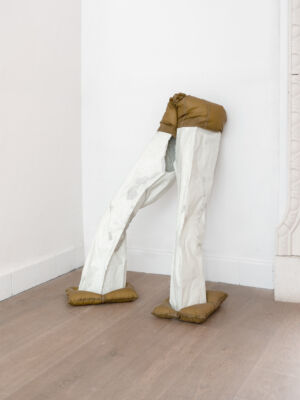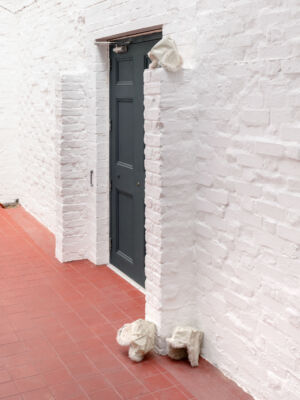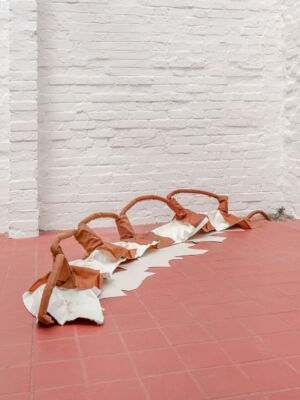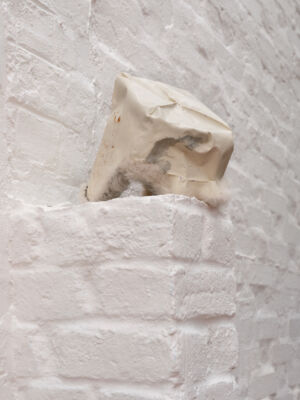Hansol Kim and Arrange Whatever Pieces Come Your Way
‘Stitch ‘i’ Story’
Curated by Heejo Kang
Presented by Apsara Studio
June 26th – July 26th, 2025. Apsara Studio, 200 Battersea Park Rd, SW11 4ND London

Installation view, ‘Stitch ‘i’ Story’, 2025. Curated by Heejo Kang. Hansol Kim and Arrange Whatever Pieces Come Your Way (Sheelagh Boyce and Annabelle Harty)
Apsara Studio is pleased to present Stitch ‘i’ Story, a dual exhibition with Seoul-London-based artist Hansol Kim and Glasgow-London-based Arrange Whatever Pieces Come Your Way’s Sheelagh Boyce and Annabelle Harty, curated by Heejo Kang, researcher/editor and a recent guest programmer at Queer East.
From the glass façade to the interior space, the Battersea studio becomes a place where the works of two artists, based on the concept of garments intertwine. While ‘stitch’ typically refers to the needlework in sartorial terms, its meaning extends beyond that — encompassing figures used in welding or writing, such as emphasis or omission, and expanding into a medium that connects the self with history. Liminal state and ability to morph of stitches correspond to the artists’ works, leading to openness and acceptance to change.
Kim’s works focused on the role of clothing as a medium that reflects the zeitgeist. The series presented in this exhibition, in addition to this, is inspired by the various plumbing systems around us, using fluidity and nature based on unity as key concepts. These can represent the cyclical nature of fashion trends or the mechanisms that repeated forms take on. He is particularly intrigued by these and how the spirit of the time seems to gain momentum within a collective, much like how individual forces converge into a larger current. Not only are pipes used and directly referenced in the forms of the works, but various components such as epoxy, foam cord, and wooden panels are also employed to reveal the systemic context of society and our place within it.
Quilts of Boyce and Harty contain relationships. All works are influenced by traditional American and Japanese quilt-making techniques, either owned by their friends and family members or rooted in memories of them. These elements mediate between the artists and owners, naturally reflecting the memories and creating a sense of cohesion. Materials—such as coats, tunics, and workers’ vests—may differ slightly in design, but they share fluid, unity, and draping lines. The patterns arranged on the cotton fabric, with stitch dash lines, appear as if they are guiding folds—like symbols suggesting potential movement. They visually represent a state of variability, not of confrontation, but of a possibility just before escalation.
From Kim’s window installation, a whole series with flooring materials are placed throughout the space, leaning against the walls or scattered on the floor. This allows the audiences to see the flow of different manners of stitches. Four quilts by Boyce and Harty are displayed in a somewhat experimental manner, either hanging from the ceiling or installed behind wooden panels.
Heejo Kang is a Seoul-London-based researcher/curator and editor interested in seeing things through a camera lens, film to moving images, and broader subculture inspired by those. Her concern starts from how we can bring these into the realm of curatorial which we have traditionally dealt with differs. She keeps an eye on the surroundings, not only the artworks themselves but also the surroundings, especially the ‘immersive experience/space’, such as the relationship between institutions, artists, and audiences. Existentialism of space and individuals, more like how institutions present works in line with artists’ intentions and how audiences more effectively engage with artworks, elaborating further, extends to intimacy issues about audiences and the public. Sometimes modern institutions fail to deal with their white cube space and the concept of a ‘black box’, transcending boundaries of both, neglecting to consider that their actions inflict more harm than good. This is also connected to audiences’ interpretation and even aesthetic experience, furthermore, it impacts the existence of the artists, even seeking to venture beyond pre-determined/fixed images from White Western perspectives.
Since 2024, she has been actively engaged as a member of the subculture collective Misiche, contributing to and co-editing its ongoing anthology series. She recently served as a Guest Programmer for Queer East, a London-based festival spotlighting LGBTQ+ films, performances, and moving image works from Southeast Asian diaspora communities. Her curatorial portfolio includes exhibitions such as The Text of Warm and Cold, http://body.download.manual, Annihilation, Romance Is A Place, and Shapable, among others. In addition, she contributed to and published Phonograph Edition, an independent music discourse publication, presented at Unlimited Edition 16 (Seoul Art Book Fair), held at the Buk-Seoul Museum of Art. Organised Taekho Kim’s first publication Homeward and showcased at the book fair Offprint in Tate Modern, Heejo is currently developing Fissure of a Sweetdream in Seoul, a solo exhibition of Shanghai-London-based photographer Jialin Yan’s solo show and photobook launching at Treelikeswater.
Hansol Kim explores fashion and clothing with an unwavering passion and obsession and delves into the multifaceted roles and formal possibilities of attire from the social, political, economic and cultural aspects.
In experiments with the form of clothes, he captures the systemic circulation of contemporary trends through practices of deconstructing and reconstructing clothing as his sculptural grammar. His artistic approach, the potential for garments to transcend their protective quality for the human body, takes clothes to be independent creatures which adopt strategies of natural organisms such as symbiosis, parasitism and mimicry, among others. Thus, he decontextualises his speculative sculpting of clothing and its inherent value with varied craft-based techniques. Kim explores the concept of multidimensionality in garments through hybridised sartorial elements. He draws inspiration from a wide range of contemporary political, social, and economic phenomena, distilling them into numerical or 2-dimensional interpretations such as charts and survey results, and incorporating these into his 3-dimensional sculptures. His research manifests both overtly and subtly within the artwork, demanding a nuanced interconnection. By employing this approach, his works acquire multidisciplinary significance, prompting a reevaluation of the relationship between garments and the newly conceived societal landscape.
He has presented his work at such solo exhibitions Like a Cloth to a Frame (Sothu, Zurich, 2022), Anatomies in Limbo (Het Nieuwe Instituut, Rotterdam, 2020), along with group shows such as What Things Dream About (The National Museum of Modern and Contemporary Art, Seoul, 2024), Tasty Shield (Industra, Brno, 2024), After Hours (ONE AND J. Gallery, Seoul, 2024) and others.
Arrange Whatever Pieces Come Your Way is a partnership between Sheelagh Boyce and Annabelle Harty, which through the creation of handsewn quilts and reconstructed fabric works explore the poetry of a dense net of visual as well as spatial relations found in formal textile constructions, built architectures, and their natural environments.
Arrange Whatever Pieces Come Your Way have presented their work in Solo exhibitions at among others, Glasgow Print Studio for GI Festival in 2021, Linn Lühn, Düsseldorf, 2021, Tanya Leighton, Los Angeles, 2022 , The Modern Institute, Glasgow, 2022 ,The Day Before Sewn Into Sleep, Haubrok Foundation, Berlin, Germany (Solo with Martin Boyce ) 2024. As well as group shows Space Forgets You, The Modern Institute for Dovecot Studios, Edinburgh 2022 and Craft, curated by Nicolas Trembley, Galerie Francesca Pia, Zurich 2023.







